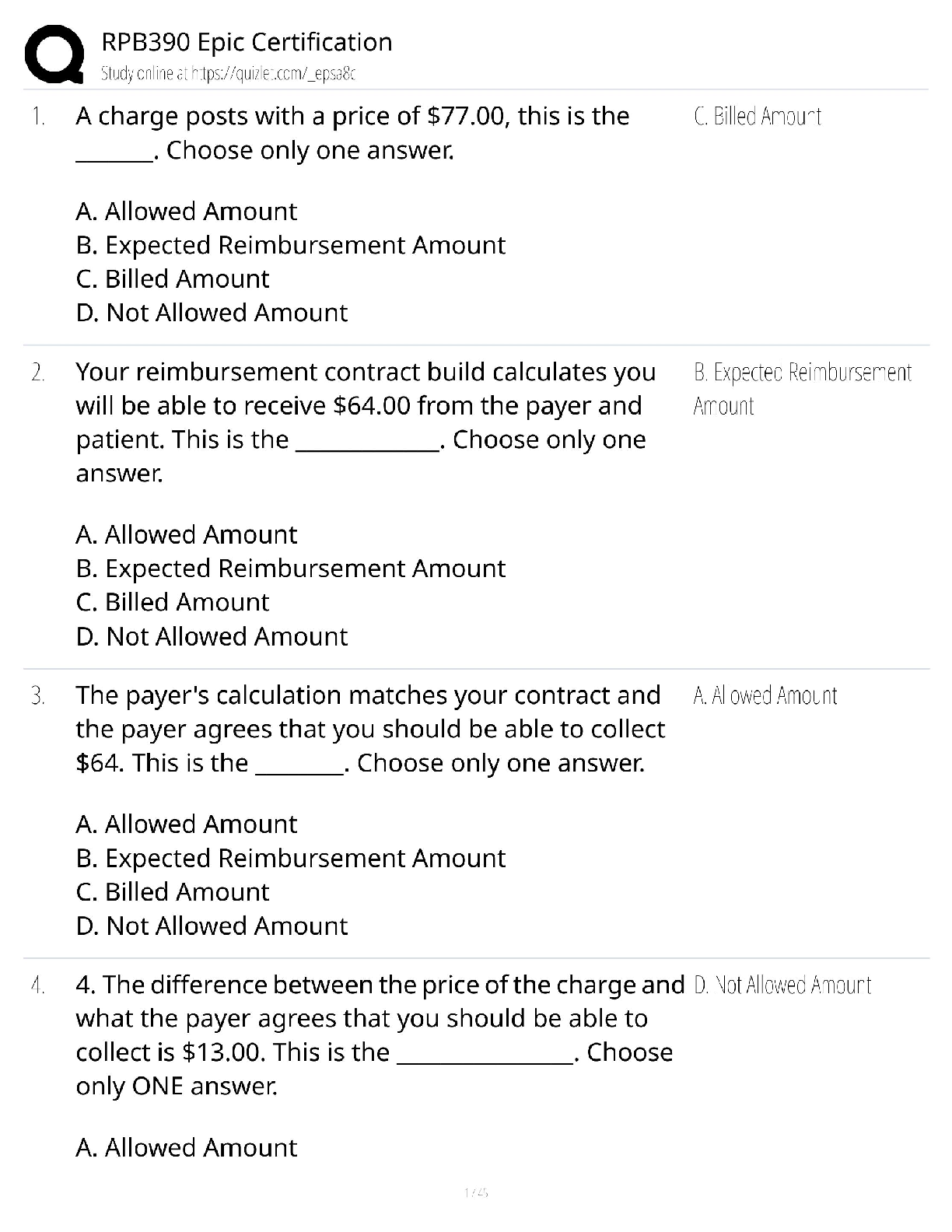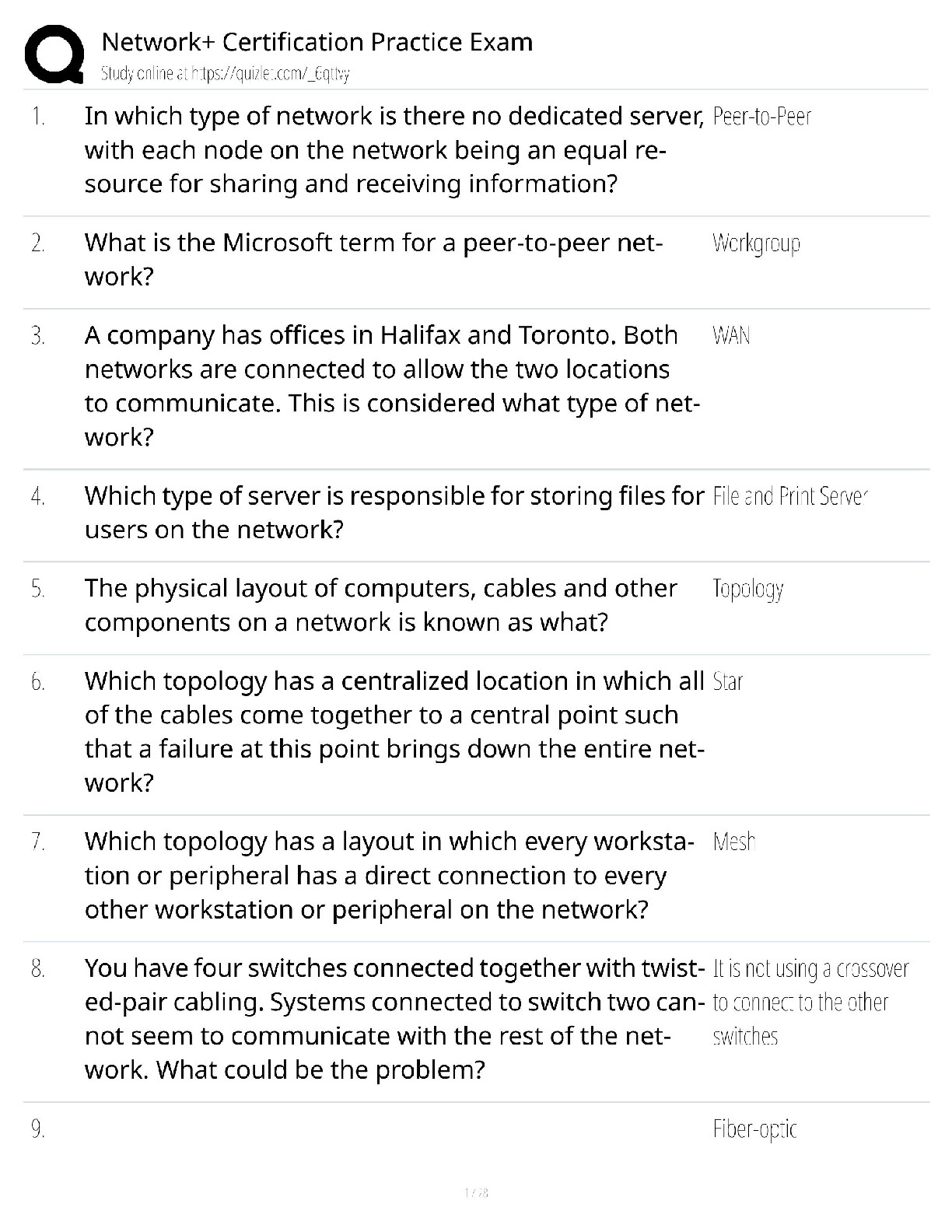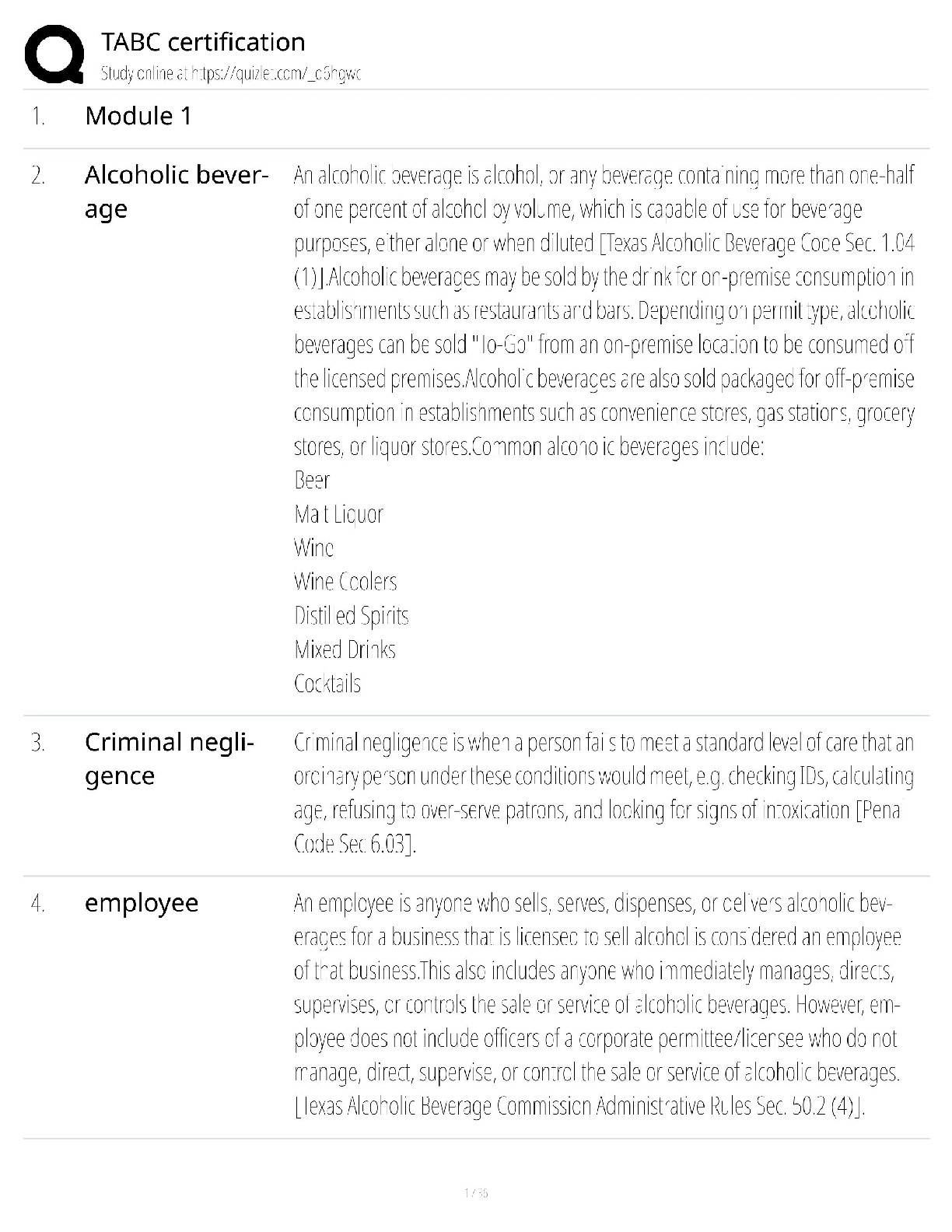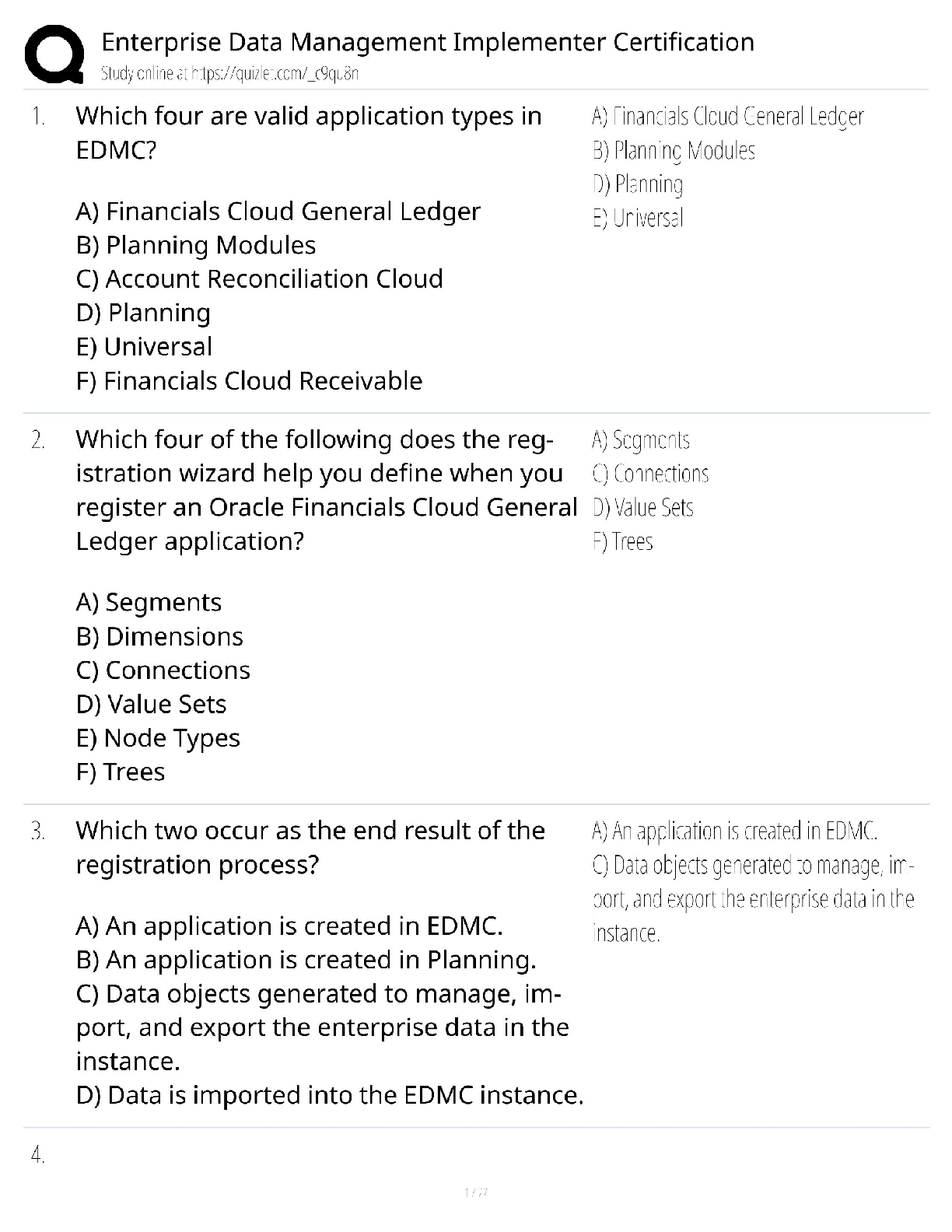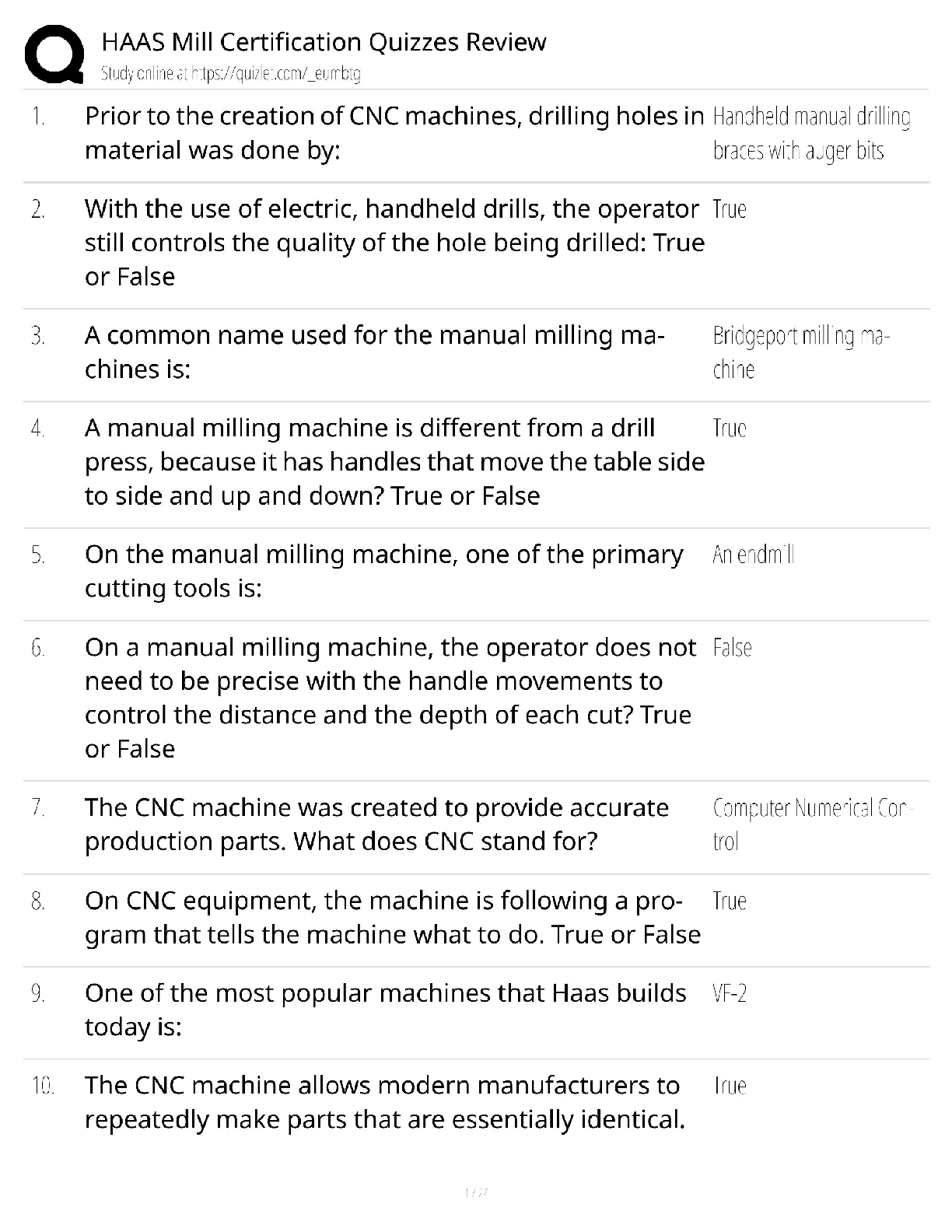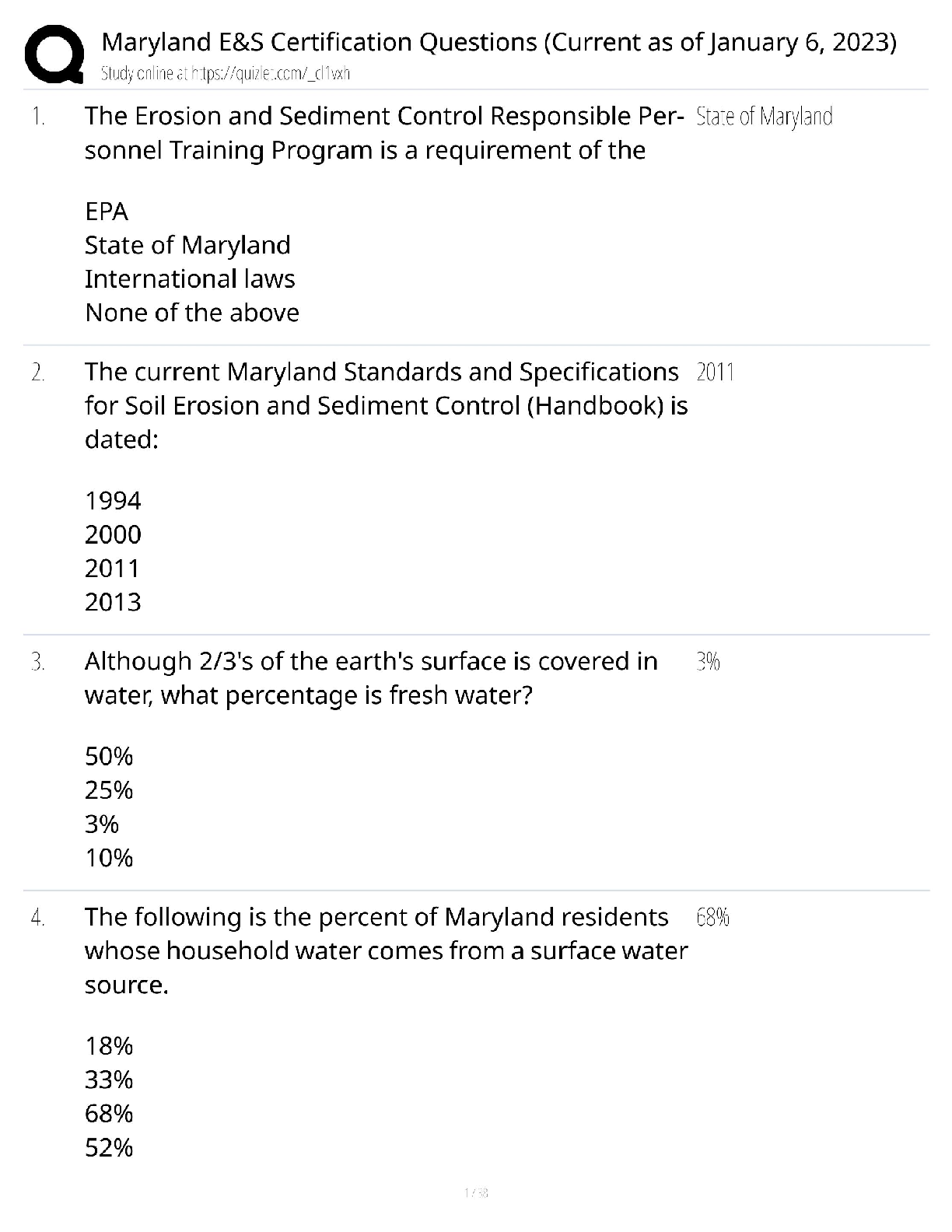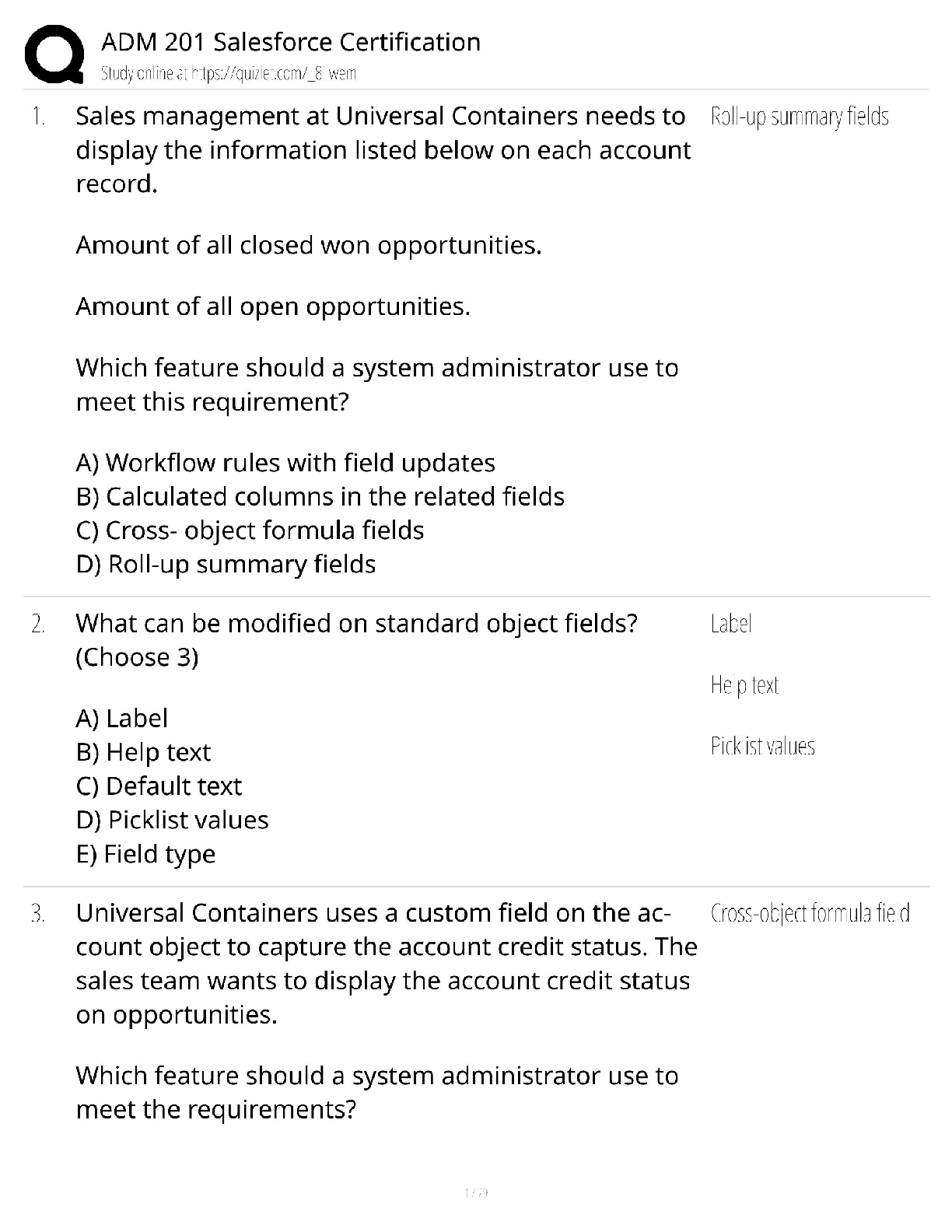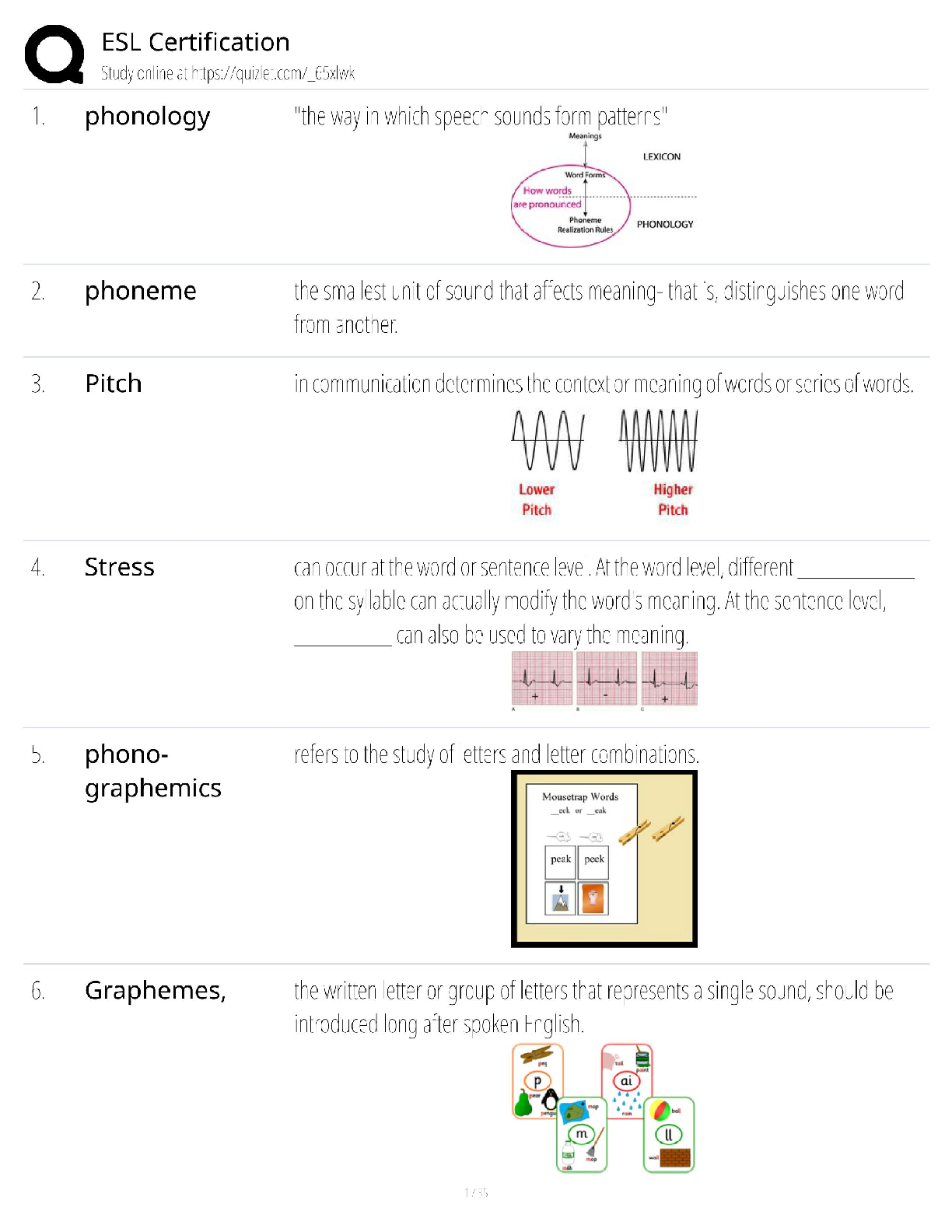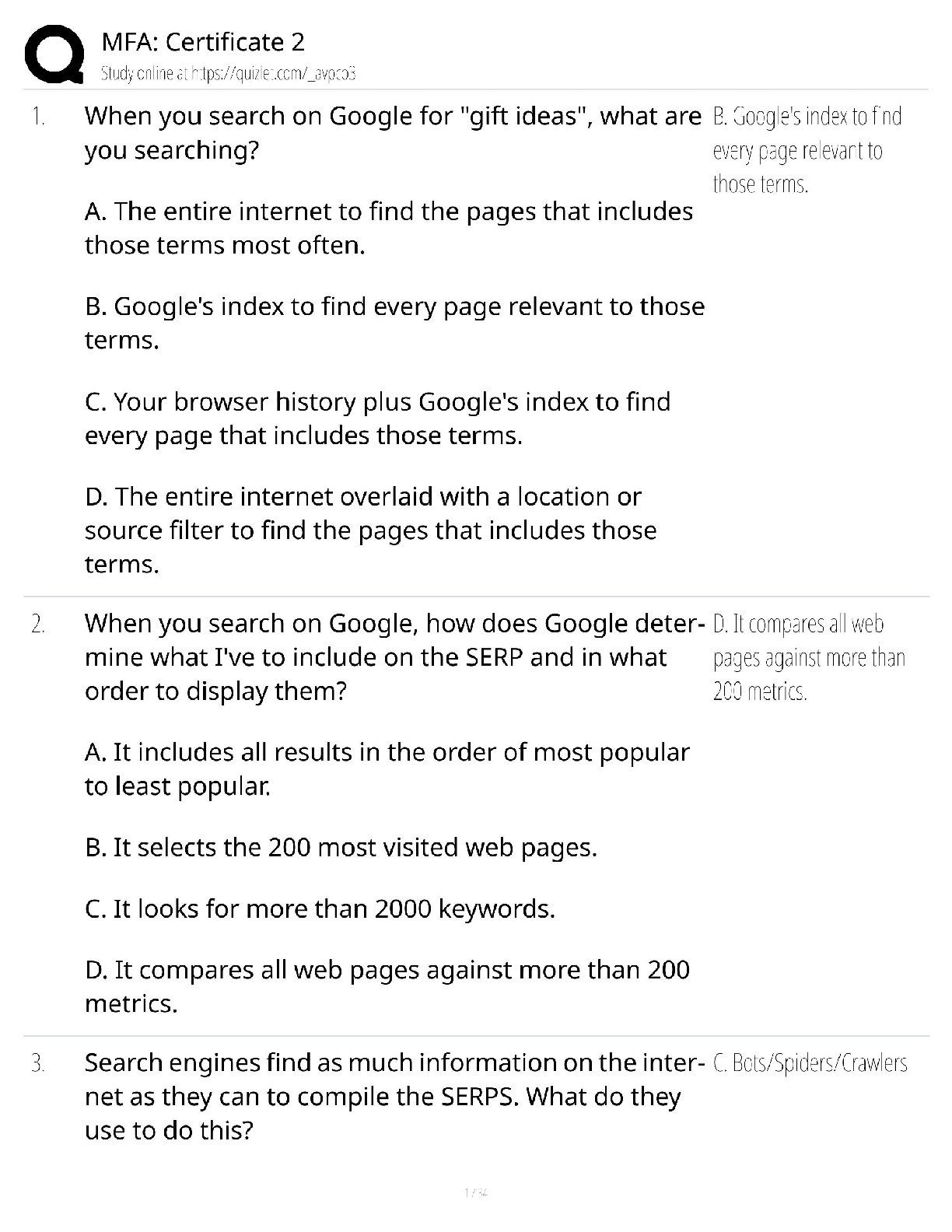*NURSING > QUESTIONS & ANSWERS > CNL certification review questions with 100% Accurate answers. Graded A+ (All)
CNL certification review questions with 100% Accurate answers. Graded A+
Document Content and Description Below
A team charter includes all except which of the following? A. Clearly defined goals B. Specific outcomes C. Team member roles D. Time allotted for each activity - ☑☑D. Rationale: A team char ... ter is an essential written agreement defining what the team is going to accomplish, how success will be measured, and defining team member roles. As a clinical nurse leader (CNL), you know a potential use of a patient's individual electronic health record is its use in A. Finding relevant evidence-based literature B. Performing a root cause analysis C. Implementing a best practice change D. Reviewing unit practice trends - ☑☑B. Rationale: Each is a potential use of healthcare information technology, but only the root cause analysis involves the use of a patient's medical record. Lateral integration is based on the understanding of which of the following? A. Patient-specific healthcare needs B. The interdependency of all healthcare disciplines C. The variety of healthcare delivery settings D. Changes in patient care needs over time - ☑☑B. Rationale: Lateral integration is based on the understanding that all disciplines of healthcare are interdependent and essential in providing complete care to the patient. When performing ongoing assessment of a process or system, the clinical nurse leader (CNL) should include all of the following, except: A. Efficacy B. Satisfaction C. Efficiency D. Ease of change - ☑☑D. Rationale: Ease of change may be considered; however it should not prevent the CNL from taking action to improve a system or process that improves safety, efficacy, satisfaction, efficiency, or quality of care. As a clinical nurse leader (CNL) on an acute care floor, you recognize the importance of lateral integration. Which of the following examples of your role as a CNL illustrates the role of ongoing evaluation in lateral integration? A. Performing risk analysis to ensure client safety B. Assessing the appropriateness and relevancy of current or newly emerging healthcare information C. Synthesizing data to find a common goal D. Fostering rapport across professional boundaries - ☑☑B. Rationale: Assessing new or current information is key to the process of ongoing evaluation. Performing a risk analysis to ensure client safety is part of the early coordination stages. Synthesizing data is the role of collaboration. Fostering rapport is a key aspect of communication. As a clinical nurse leader (CNL) on an acute care floor, you recognize the importance of lateral integration. Which of the following examples of your role as a CNL illustrates the role of collaboration in lateral integration? A. Monitoring the plan of care for specific patients and populations B. Clearly delegating tasks and responsibilities within a team C. Translating from discipline-specific language to a common message and goals D. Keeping all members of the team informed of current status and process - ☑☑C. Rationale: Translating the message to form a common goal exemplifies collaboration within a team. Monitoring involves ongoing evaluation; clear delegation of tasks is an important aspect of coordination; updating on status is clear communication. Monitoring involves _____________ _______________. - ☑☑ongoing evaluation clear delegation of tasks is an important aspect of _____________. - ☑☑coordination updating on status is clear _______________. - ☑☑communication Performing a risk analysis to ensure client safety is part of the early _____________ stages. - ☑☑coordination In order to practice horizontal leadership, the clinical nurse leader (CNL) needs a "tool kit" of skills. These include all except which of the following? A. Vertical integration B. Use of feedback C. Healthcare outcomes D. Guiding EBP practice - ☑☑A. Rationale: Critical skills in order to practice horizontal leadership include guiding evidence-based practice, healthcare outcomes, lateral integration, use of feedback, coaching, and leading teams. The clinical nurse leader (CNL) facilitates, coordinates, and oversees care provided by the healthcare team. This best describes which of the following roles? A. Risk anticipator B. Lateral integrator C. Team manager D. Outcomes manager - ☑☑B. Rationale: Lateral integration of care involves the CNL as the leader of care; overseeing care provided by the healthcare team; identifying barriers; and working with the team to proactively manage potential problems. Fostering rapport is a key aspect of _________________ - ☑☑communication synthasizing data is ___________ - ☑☑collaboration A male patient seen at your clinic says he has recently purchased a gym membership and requests information about what types of exercises he should start with when beginning. As the clinical nurse leader (CNL) for the clinic, you recognize this patient is most likely in which of Prochaska and DiClemente's Transtheoretical Model for stages of change: A. Contemplation B. Preparation C. Action D. Maintenance - ☑☑B. Rationale: Based on Prochaska and DiClemente's Transtheoretical Model, this patient is in the preparation stage; he has taken some steps toward action showing he is seriously planning change in the near future through financial commitment and research. He has not yet reached the action phase because he has not yet modified the behavior Irene is a clinical nurse leader (CNL) in a small community hospital. Irene was tasked with leading an interdisciplinary team to improve the transition from emergency room (ER) to the medical unit. During a meeting, the ER nurses and the medical unit nurses argue over the cause of delays, blaming one another. The team is now disruptive and not focused on the goals of this group. Which of the following should the CNL do first to resolve this conflict? A. Define the problem. B. Develop plan of action. C. Evaluate underlying causes. D. Determine an approach. - ☑☑A. Rationale: The first step in problem solving is to define the problem. Diane is a 43-year-old female who has been readmitted three times in the past 6 months with chronic obstructive pulmonary disease (COPD) exacerbations. Diane has been described as noncompliant with taking her medications and she continues to smoke half a pack of cigarettes daily. Which of the following best describes the first critical step when developing a plan of care for Diane? A. Refer Diane to a smoking cessation class. B. Coordinate with respiratory therapy to teach Diane correct technique for inhalers. C. Auscultate Diane's lungs to evaluate for wheezing. D. Ask Diane what she feels is causing her to come back to the hospital. - ☑☑D. Rationale: Developing a therapeutic relationship is the first step in a clinical assessment. It is important to obtain information from the patient, including his or her perspective and goals. The clinical nurse leader (CNL) is asked to lead an interdisciplinary team in developing a pathway to help improve the discharge process. The CNL helps the team create an agreement that focuses on goals, outcomes, and team member roles. Which of the following best describes the team leader tool the CNL is creating? A. Team agenda B. Team ground rules C. Team charter D. Team evaluation - ☑☑C. Rationale: team charter is an essential written agreement defining what the team is going to accomplish, how success will be measured, and defining team member roles. There are three dimensions of safety: safety climate (compliance with rules and no-fault error reporting); teamwork climate (collaboration and communication); and which of the following? A. Employee climate (teamwork and engagement) B. Positive perceptions of management (working conditions, opinions of management) C. Positive perceptions of coworkers (engagement and low turn-over rates) D. Caring climate (values, ethics, and patient experience) - ☑☑B. Rationale: Hudson et al identified position perception of management as the third dimension. A 24-bed critical care unit has experienced an increase in ventilator-associated pneumonia (VAP) within the past year. The clinical nurse leader (CNL) is asked to facilitate a workgroup focused on developing a plan to prevent VAP. Which of the following best exhibits how the CNL promotes communication within the team? A. Assigns each member a role, ensuring everyone understands his or her job. B. Engages the team in shared decision making before finalizing a plan. C. Shares clear goals, messages, and plans with the team throughout the process. D. Synthesizes the input from the team to find common themes and goals. - ☑☑C. Rationale: The CNL communicates within a team by fostering the flow of information and serving as a translator. The CNL actively solicits input and shares information with the team. Which of the following defines horizontal leadership? A. It is a leadership style that depends on high levels of communication from management to meet goals. B. Managers and team members set predetermined goals together, and employees agree to follow the direction and leadership of the manager to accomplish those goals. C. It values the input of team members and peers, but the responsibility of making the final decision rests with the participative leader. D. It is a philosophy of organizational leadership whereby the structure promotes equality and an "open-door policy." - ☑☑D. Rationale: It allows team members to voice their opinions and to provide feedback freely. As a clinical nurse leader (CNL), it is important to share outcomes and disseminate findings. Which of the following do you recognize as the most appropriate outlet for your findings? A. Journal and conferences only B. Founder of journal and conference C. Journal, conference, TV, and radio D. Journal, conference, founder of journal, TV, and radio - ☑☑D. Rationale: All of the above are appropriate places to disseminate results. Which of the following are Hallmarks of a Healthy Work Environment? A. Skilled communication, true collaboration, meaningful recognition, and authentic leadership B. Autonomy, patient- and self-advocacy, collaborative teamwork, and professional communication C. Transformational leadership, efficient decision making, high staffing, and at least 80% of nurses having a BSN degree and/or certification D. Meaningful recognition, transformational leadership, collaborative teamwork, and professional communication - ☑☑A. Rationale: The six American Association of Colleges of Nursing (AACN) Hallmarks of a Healthy Work Environment are: skilled communication, true collaboration, effective decision making, appropriate staffing, meaningful recognition, and authentic leadership. LATERAL INTEGRATION & THE CNL ROLE Seeking input from other members of the healthcare team is ____________ - ☑☑collaboration LATERAL INTEGRATION & THE CNL ROLE Ensuring role identity is _____________. - ☑☑coordination LATERAL INTEGRATION & THE CNL ROLE Evaluating processes is part of ____________ ______________ - ☑☑ongoing evaluation As a clinical nurse leader (CNL) on an acute care floor, you recognize the importance of lateral integration. Which of the following examples of your role as a CNL illustrates the role of communication in lateral integration? A. Seeking other members of the healthcare team to provide their input on a new nursing process B. Ensuring that each member of the interdisciplinary team knows his or her role and workflow C. Asking questions to clarify and restate information D. Evaluating communication strategies and processes within a team - ☑☑C.Rationale: Clarifying verbal and nonverbal messages is a major aspect of communication. Seeking input from other members of the healthcare team is collaboration; ensuring role identity is coordination; while evaluating processes is part of ongoing evaluation. Alex, a clinical nurse leader (CNL) in a pediatric clinic, is conducting a gap analysis in order to compare best practices with the current processes. After determining the state of the microsystem, Alex should do which of the following next? A. Determine desired state based on benchmark data. B. Prioritize needs and determine importance. C. Analyze the gap between the current state and desired state. D. Identify potential solutions and opportunities for improvement - ☑☑A. Rationale: A gap analysis is conducted by determining the state of the microsystem and then determining the desired state based upon benchmark data. As you begin to investigate the sentinel event, what is one way you can present a GRAPHICAL representation of the different factors that contributed to the issue? A. an RCA B. a fishbone diagram C. a concept map D. a cinical decision tree - ☑☑B. a fishbone diagram The team wants to implement the process change and observe what happens, but they are unsure what method to use. What method do you suggest? A. 5S B. 5P C. FMEA D. PDSA - ☑☑D. PDSA Value-based purchasing is the method of payment by CMS for in-hospital stays, which pays on the basis of hospital scores in patient experience of the _______________. - ☑☑HCAHPS HCAHPS, the "A" stands for _______________. - ☑☑Assessment HCAHPS, the "HP" stands for ___________ _______________. - ☑☑Healthcare Provider HCAHPS, the "H" stand for ______________ . - ☑☑Hospital HCAHPS, the "S" stands for _____________. - ☑☑Systems The CNL is aware of the _________, ___________, and ___________ messages that are being portrayed to the team members. - ☑☑verbal, nonverbal, and written A new graduate nurse, Jenny, approaches you and states she needs help removing a PICC line. Which of the following is the best response when acting as a horizontal leader? A. Remove the PICC line yourself B. Tell Jenny to find the policy and then remove the PICC C. Help Jenny find the policy and review it with her. Coach Jenny while she removes the PICC line and provide feedback D. Help Jenny find the policy and refer her to a nurse with 12 years of experience for assistance - ☑☑C. Rantional: horizontal leadership What organizational theory is used with rapid, unpredictable, and constant change? A. Systems theory B. Chaos Theory C. Change Theory D. Traditional Theory - ☑☑B. Rationale: suitable for healthcare systems Your hospital is currently trialing the integration of the CNL role. At the end of the trial implementation period how can you, as the CNL, best illustrate the effectiveness of your role during this trial? A. Refer to increased patient satisfaction scores over the course of the trial B. Present data that demonstrates the effect of the CNL and outcomes over the course of the trial C. Present a list of projects and tasks completed over the course of the trial D. Refer to your performance review over the course of the trial - ☑☑B. rationale: present effects and outcomes A CNL evaluates a 17-year old patient who has been sexually assaulted. The patient has visible bruising and head laceration. After the CNL's assessment, law enforcement officials have contacted the CNL requesting information regarding the attack and the visible injuries. The CNL knows the priority is to take what initial action? A. The pictures and complete the rape kit B. Provide law enforcement with a record as requested C. Call the patient's parents first D. Explain to the patient in order to obtain consent for release of records - ☑☑D. rationale: HIPPA A CNL in the NICU is collecting data on the hours worked weekly by the staff nurses. The CNL wants to see if there is a normal distribution of hours worked. What techniques is the best to display the distribution of the data collected? A. Run chart B. Fishbone chart C. FMEA chart D. Histogram chart - ☑☑D. Rationale: graphic illustation for distribution of data without timelines (run chart) or sentinel events (fishbone) The CNL is performing RCA for spike in number of CAUTIs over the last 6 months. Realizing CMS operates on a pay-for-performance basis, you develop a CAUTI task force in an effort to reduce costs. This is an example of A. Implementing cost reduction and savings B. Anticipating risk and designing plans of care to Improve outcomes C Evaluating the effect of the health care financing on care access and patient outcomes D. Applying basic business and economic principles to the microsystem - ☑☑B. rationale core competencies The CNL notices increased number of CLBSI on your unit. You conduct a literature search and, after critiquing and synthesizing the available evidence, you find that central line bundles have been shown to decrease CLBSI. You want to implement this bundle on your unit, and plan to evaluate the effect of this change. Which of the following best describes this process? A. PDSA B. Research C. QI D. EBP - ☑☑D. Rationale: EBP involves applying research evidence to clinical practice in order to improve patient outcomes The CNL successfully implemented an EBP project utilizing music therapy to help with pain control in sickle cell patients on a medical-surgical unit. The CNL was asked by the CNO to implement the project within the medical division. What system will the CNL be working in? A. mesosystem B. macrosystme C. microsystem D. unit-based system - ☑☑A. rationale: multiple microsys [Show More]
Last updated: 3 years ago
Preview 1 out of 26 pages

Buy this document to get the full access instantly
Instant Download Access after purchase
Buy NowInstant download
We Accept:

Also available in bundle (1)
Click Below to Access Bundle(s)
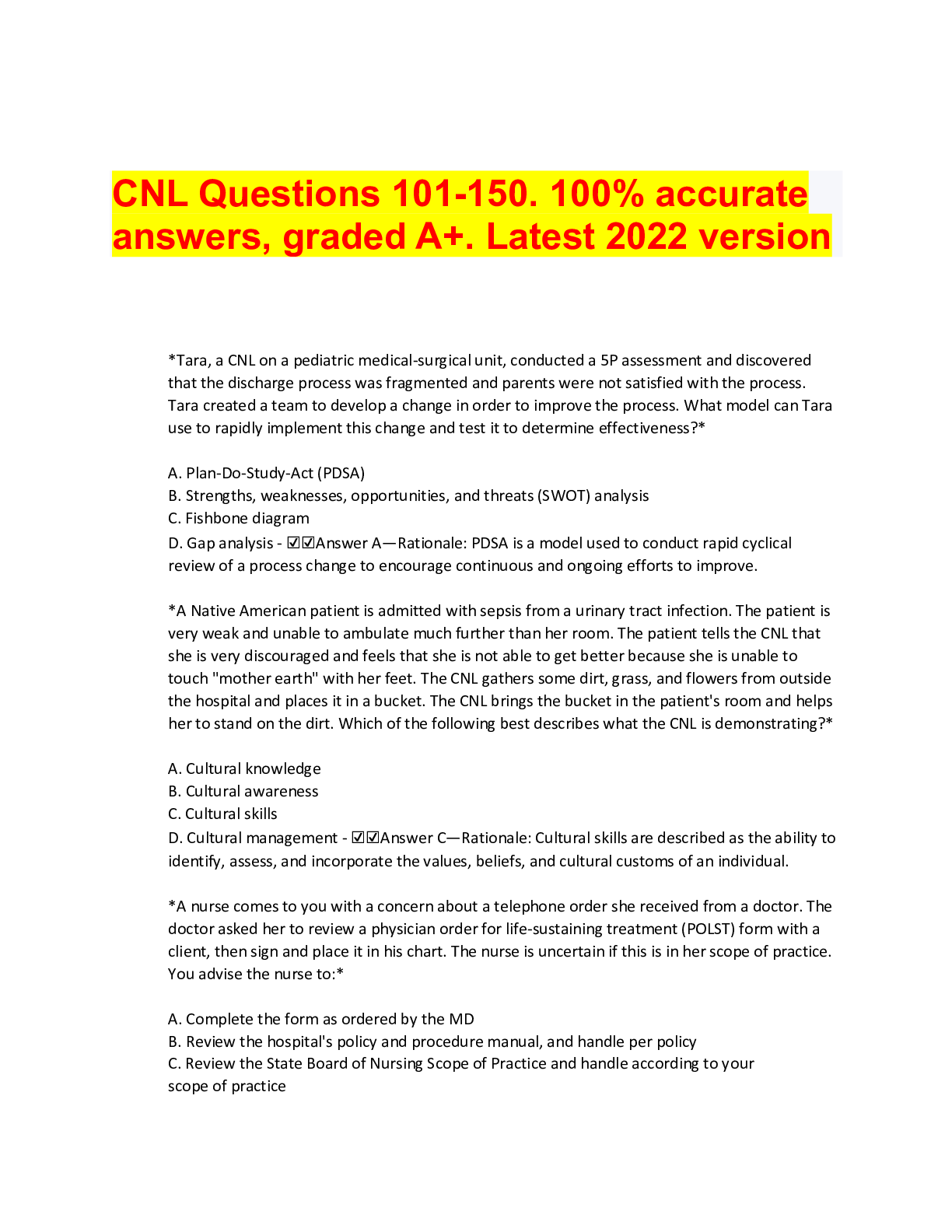
ALL CNL EXAM DOCUMENTS; QUESTIONS AND ANSWERS. PREDICTOR QUESTIONS. DOWNLOAD TO SCORE A+
Composed of 8 documents. All CNL questions and answers, latest versions 2022. rated A+
By bundleHub Solution guider 3 years ago
$28
8
Reviews( 0 )
$12.00
Can't find what you want? Try our AI powered Search
Document information
Connected school, study & course
About the document
Uploaded On
Aug 07, 2022
Number of pages
26
Written in
All
Seller

Reviews Received
Additional information
This document has been written for:
Uploaded
Aug 07, 2022
Downloads
0
Views
130













